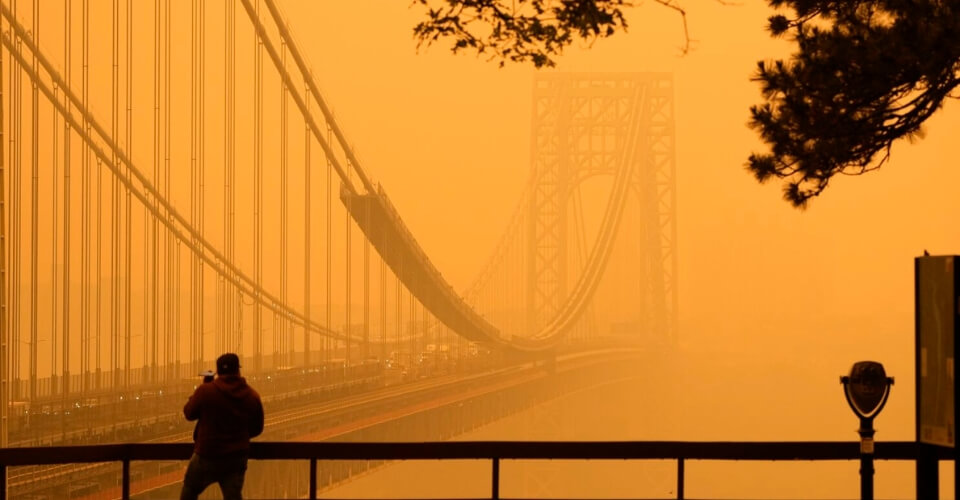The Canadian fires are the much-needed wake-up call for the changing climate rhetoric. An imperative action and collective decision are the only resolutions to stop the wildfires at present and from future catastrophes.
Since the past few months, the repercussions of Canadian wildfires have traveled across borders, creating an atmosphere of health hazards.
A few weeks back, New York City suffered from the yellow hues of potential threat. The smoke was so intense that people had to confine themselves to their homes while stocking groceries, medicines, and other supplies. The state alerted the citizens on the low air quality and advised them to only get out of the house in dire emergencies. The unbearable smoke also dispensed a smell of burning wood, making it difficult for people to breathe.
But Chicago gets the worst hit from these fires, as the city suffers an exponential rise in the AQI (Air Quality Index).
Why Is Chicago So Smoky?
The raging fires in Quebec and Ontario are still not under control, despite the grueling efforts by the service workers and officials. The smoke from these fires compounds into a thick layer, enveloping the city entirely.
After engulfing Canada, the smoke progressed toward the USA. Nebraska had a first-hand encounter with the haze a couple of months back.
Subsequently, the smoke has now clouded Chicago, but the conditions seem worst among all USA cities.
The Environmental Protection Agency’s AirNow platform recorded a peak of more than 200 on Air Quality Index (AQI) at around 4 p.m. on Tuesday. The AQI was fluctuating at unhealthy levels throughout the day.
But why is Chicago experiencing such extreme levels of low air quality?
Scott Collis, Argonne National Laboratory atmospheric scientist, explains the phenomenon of atmospheric inversion–
“What that does is, it puts a cap on the atmosphere. It means that it makes it very difficult for smoke to rise, so a lot of that wildfire smoke got trapped under that inversion that actually caused this.”
“If I look out my window right now, you’d swear that it was overcast, but there are actually no clouds above us right now. That’s all smoke.”
Simply put– atmospheric inversion is a horizontal layer of air that increases in temperature along the altitude. All the smoke is trapped under this layer, thus leading to adverse air quality.
When Will the Air Quality in Chicago Get Better?
The National Weather Service has alerted Chicagoans of Unhealthy Air Quality that will continue through midnight on Wednesday. As per the forecast, there might be a bout of relief on Wednesday morning, but the smoky haze will overpower the city by afternoon.
The air quality is not expected to improve anytime soon, considering the active wildfires in Canada. The longest estimate for the smoke in Chicago is around a week, as observed in NYC and other cities.
You can follow a few measures to protect yourself, as stated here.
Wear an N95 or KN95 mask before going out.
Which City Has the Worst Air Quality in the US?
Currently, Chicago and Detroit are the worst-hit cities with smoke and increasing air pollution.
Chicago’s mayor Brandon Johnson has issued a statement assuring the citizens that the city is monitoring the situation. He also urges people with heart and lung diseases, children, teens, senior citizens, and pregnant women to avoid strenuous activities and restrict their time outside. Here is the brief of the statement–
“For additional precautions, all Chicagoans may also consider wearing masks, limiting their outdoor exposure, moving activities indoors, running air purifiers and closing windows.”
“As these unsafe conditions continue, the City will continue to provide updates and take swift action to ensure that vulnerable individuals have the resources they need to protect themselves and their families. Anyone who needs immediate medical attention should dial 911.”
Does Smoke Affect Air Quality?
As stated earlier, Chicago air is trapped due to atmospheric inversion, which amplifies the ramifications of the smoke. This layer confines the air pollutants beneath or within the layer. This gradually increases the concentration in the volume of air. If it weren’t for this trapping layer, the air would have diluted the air pollutants throughout a vast portion of the troposphere.
The other characteristic of the smoke is that it carries fine particulate matter that can penetrate one’s body easily. Any particulate less than 2.5 microns is considered extremely hazardous. According to AirNow.gov, Chicago recorded a PM 2.5 which obscures visibility and causes haziness. This also contributes significantly to poor air quality.
What do you think of the rising concerns in air quality? Are you taking suitable precautions before going out?
Let us know your thoughts in the comments section below.

